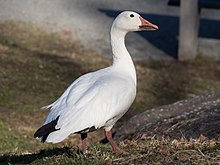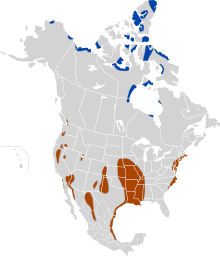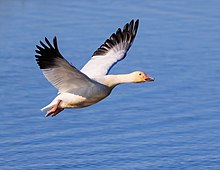Snow goose
| Snow goose | |
|---|---|

| |
| White morph | |

| |
| Blue morph | |
| Scientific classification | |
| Domain: | Eukaryota |
| Kingdom: | Animalia |
| Phylum: | Chordata |
| Class: | Aves |
| Order: | Anseriformes |
| Family: | Anatidae |
| Genus: | Anser |
| Species: | A. caerulescens
|
| Binomial name | |
| Anser caerulescens | |
| Subspecies | |

| |
| Snow goose range: Breeding range (also in northwest Greenland and Wrangel Island, Russia; not shown) Wintering range
| |
| Synonyms | |
| |
The snow goose (Anser caerulescens) is a species of
Snow geese breed north of the timberline in Greenland, Canada, Alaska, and the northeastern tip of Siberia, and spend winters in warm parts of North America from southwestern British Columbia through parts of the United States to Mexico.[4] Snow goose populations increased dramatically in the 20th century.
Taxonomy
In 1750 the English naturalist
Two subspecies are recognised:[8][11]
- A. c. caerulescens (Linnaeus, 1758) – lesser snow goose – breeds in northeast Siberia, north Alaska and northwest Canada, winters in south USA, north Mexico and Japan
- A. c. atlanticus (Kennard, 1927) – greater snow goose – breeds in northeast Canada and northwest Greenland, winters in northeast USA
The greater snow goose is distinguished from the
Description

The snow goose has two color
White- and blue-morph birds interbreed and the offspring may be of either morph. These two colors of geese were once thought to be separate species; since they interbreed and are found together throughout their ranges, they are now considered two color phases of the same species. The color phases are genetically controlled. The dark phase results from a single dominant gene and the white phase is homozygous recessive. When choosing a mate, young birds will most often select a mate that resembles their parents' coloring. If the birds were hatched into a mixed pair, they will mate with either color phase.
The species is divided into two
Breeding
Long-term pair bonds are usually formed in the second year, although breeding does not usually start until the third year. Females are strongly philopatric, meaning they will return to the place they hatched to breed.
Snow geese often nest in colonies. Nesting usually begins at the end of May or during the first few days of June, depending on snow conditions. The female selects a nest site and builds the nest on an area of high ground. The nest is a shallow depression lined with plant material and may be reused from year to year. After the female lays the first of three to five eggs, she lines the nest with down. The female incubates for 22 to 25 days, and the young leave the nest within a few hours of hatching.
The young feed themselves, but are protected by both parents. After 42 to 50 days they can fly, but they remain with their family until they are two to three years old.
Where snow geese and Ross's geese breed together, as at La Pérouse, they hybridize at times, and hybrids are fertile. Rare hybrids with the greater white-fronted goose, Canada goose, and cackling goose have been observed.[4]
Migration
Snow geese breed from late May to mid-August, but they leave their nesting areas and spend more than half the year on their migration to-and-from warmer wintering areas. During spring migration (the reverse migration), large flocks of snow geese fly very high and migrate in large numbers along narrow corridors, more than 3,000 mi (4,800 km) from traditional wintering areas to the tundra.
The lesser snow goose travels through the
In March 2015, 2,000 snow geese were killed in northern
Vagrancy
The snow goose is a rare vagrant to
Around 2015, a small group of 3-5 snow geese landed on the north shore of
In Central America, vagrants are frequently encountered during winter.[15]
Ecology
Outside of the nesting season, they usually feed in flocks. In winter, snow geese feed on left-over grain in fields. They migrate in large flocks, often visiting traditional stopover habitats in spectacular numbers. Snow geese frequently travel and feed alongside
The population of greater snow geese was in decline at the beginning of the 20th century, but has now recovered to sustainable levels. Snow geese in North America have increased to the point where the tundra breeding areas in the Arctic and the saltmarsh wintering grounds are both becoming severely degraded,[16] and this affects other species using the same habitat.
Major nest predators include
Population
The breeding population of the lesser snow goose exceeds 5 million birds, an increase of more than 300% since the mid-1970s. The population is increasing at a rate of more than five percent per year. Non-breeding geese (juveniles or adults that fail to nest successfully) are not included in this estimate, so the total number of geese is likely higher. Lesser snow goose population indices are the highest they have been since population records have been kept, and evidence suggests that large breeding populations are spreading to previously untouched sections of the Hudson Bay coastline. The cause of this overpopulation may be the heavy conversion of land from forest and prairie to agricultural usage in the 20th century.
Since the late 1990s, efforts have been underway in the U.S. and Canada to reduce the North American population of lesser snow and Ross's geese to sustainable levels due to the documented destruction of tundra habitat in Hudson Bay and other nesting areas. The Light Goose Conservation Order was established in 1997 and federally mandated in 1999. Increasing hunter bag limits, extending the length of hunting seasons, and adding new hunting methods have all been successfully implemented, but have not reduced the overall population of snow geese in North America.[20][21]
Conservation order for light geese
This section includes a improve this section by introducing more precise citations. (October 2021) ) |
The late 1990s was when the mid-continent population of snow geese was recognized as causing significant damage to the arctic and sub-arctic breeding grounds which was also causing critical damage to other varieties of waterfowl species and other wildlife that uses the arctic and sub-arctic grounds for home habitat. The increase in population in substantial amounts raised concern to then DU chief biologist Dr. Bruce Batt who was part of a committee that put together various data and submitted it to the U.S. Fish and Wildlife Service and the Canadian Wildlife Service with the recommendation on ways to combat the growing population and the damage that the snow geese were creating in the arctic breeding grounds.
The committee recommended relaxing hunting restrictions and giving hunters a better opportunity to harvest more snow geese on their way back to the breeding grounds in the spring. The suggested restrictions were to allow the use of electronic callers, unplugged shotguns, extended shooting hours, and no bag limits. Two years after the Light Goose Conservation Order was introduced it was federally mandated in 1999.
Gallery
-
Anser caerulescens -MHNT
-
A. c. atlanticus, spring migration, blue morphs in foreground,Alexandria, Ontario
-
Wintering snow geese on Fir Island, Washington
-
Snow goose landing
-
Snow geese in a corn field onFir Island, Washington in the Skagit Riverdelta
-
Greater snow geese in flight
-
Snow geese (Anser caerulescens)
References
- . Retrieved 14 April 2023.
- ISBN 978-1-84330-328-2.
- ISBN 978-0-19-861008-3.
- ^ a b c Mowbray, Thomas B.; Fred, Cooke; Barbara, Ganter (2000). "Snow Goose (Chen caerulescens)". In Poole, A. (ed.). The Birds of North America Online. Ithaca: Cornell Lab of Ornithology. Retrieved 10 April 2009.
- ^ Edwards, George (1743). A Natural History of Uncommon Birds. Vol. Part 3. London: Printed for the author at the College of Physicians. p. 152, Plate 152.
- ^ Linnaeus, Carl (1758). Systema Naturae per regna tria naturae, secundum classes, ordines, genera, species, cum characteribus, differentiis, synonymis, locis (in Latin). Vol. 1 (10th ed.). Holmiae (Stockholm): Laurentii Salvii. p. 124.
- ^ Brisson, Mathurin Jacques (1760). Ornithologie, ou, Méthode Contenant la Division des Oiseaux en Ordres, Sections, Genres, Especes & leurs Variétés (in French and Latin). Paris: Jean-Baptiste Bauche. Vol. 1, p. 58, Vol. 6, p. 261.
- ^ Rasmussen, Pamela, eds. (2020). "Screamers, ducks, geese & swans". IOC World Bird List Version 10.2. International Ornithologists' Union. Retrieved 6 October 2020.
- ISBN 978-1-4081-2501-4.
- PMID 27233434.
- ^ Kenneth F. Abraham; Robert L. Jefferies (1997). Arctic Ecosystems in Peril: Report of the Arctic Goose Habitat Working Group. Part II High Goose Populations: causes, impacts and implications (PDF) (Report). U.S. Fish and Wildlife Service and Canadian Wildlife Service. p. 1. Retrieved 15 November 2020.
- )
- ^ "Light Goose Dilemma". www.ducks.org. Retrieved 2018-01-01.
- ^ "2,000 snow geese drop dead from the sky in Idaho". CNN. 18 March 2015.
- ^ Herrera, Néstor; Rivera, Roberto; Ibarra Portillo, Ricardo; Rodríguez, Wilfredo (2006). "Nuevos registros para la avifauna de El Salvador" [New records for the avifauna of El Salvador] (PDF). Boletín de la Sociedad Antioqueña de Ornitología (in Spanish and English). 16 (2): 1–19.
- ^ "Snow geese degrade tundra". The New York Times. 22 September 2014.
- ^ JSTOR 4163840.
- ^ Coakley, Amber (3 March 2009). "Duck Duck Goose – Snow Goose". Birders Lounge.
- S2CID 86264904.
- ^ "Too Many Snow Geese | Central Flyways". central.flyways.us. Retrieved 2017-12-31.
- ^ "Light Goose Dilemma". www.ducks.org. Retrieved 2017-12-31.
Further reading
- Johnson, Mike (16 July 1997). "The snow goose population problem". Northern Prairie Wildlife Research Center Online.
External links
- Conservation Order for Light Geese - Cornell Law School
- Snow Goose Species Account – Cornell Lab of Ornithology
- The Nature Conservancy's Species profile: Snow Goose Learn more about the conservation of these geese
- Snow Goose - Chen caerulescens – USGS Patuxent Bird Identification InfoCenter
- "Snow Goose". Avibase.
- Song of the North Wind: A Story of the Snow Goose by Paul A. Johnsgard(1974, rev. 2009)
- "Snow goose media". Internet Bird Collection.
- Snow goose photo gallery at VIREO (Drexel University)









